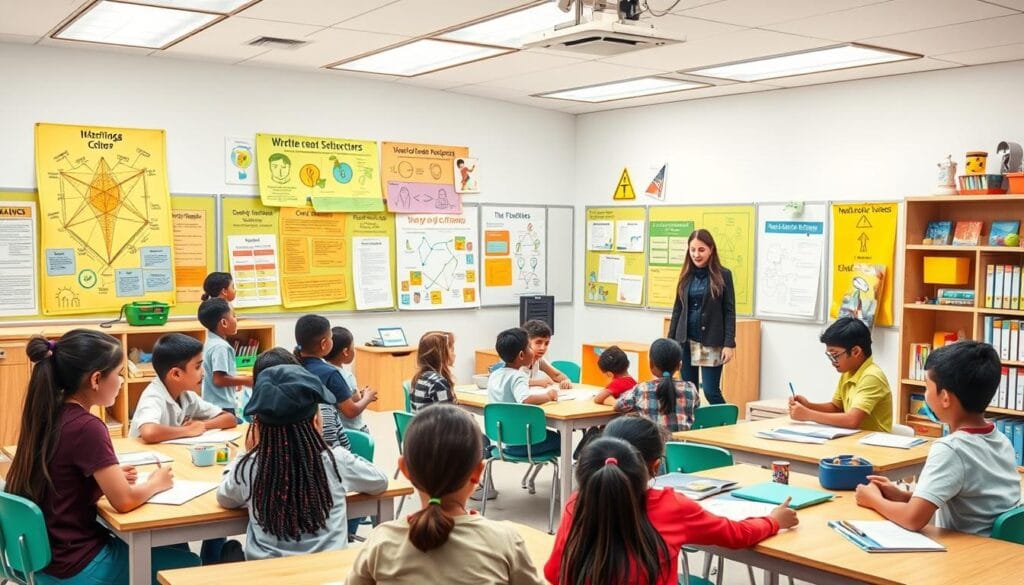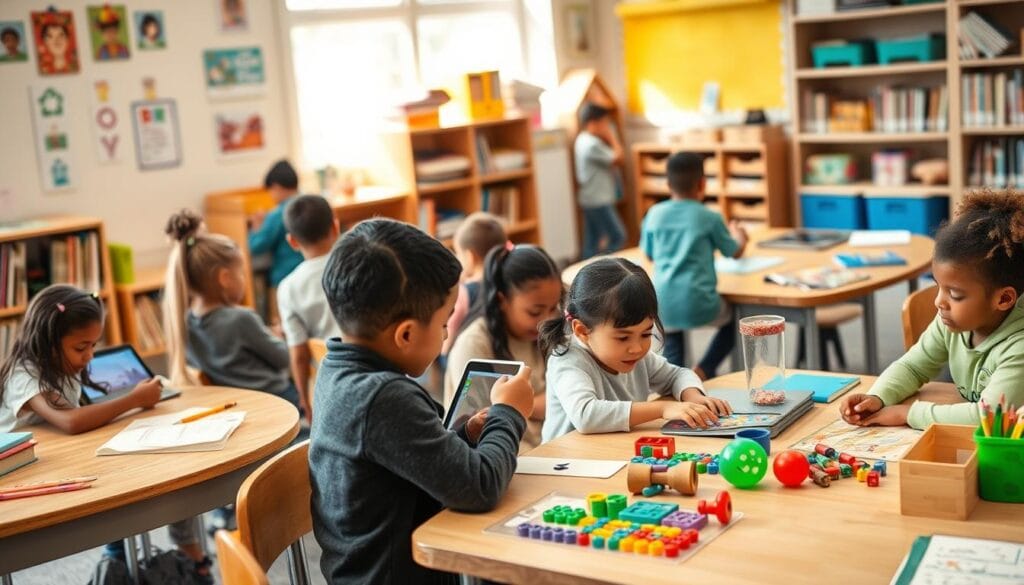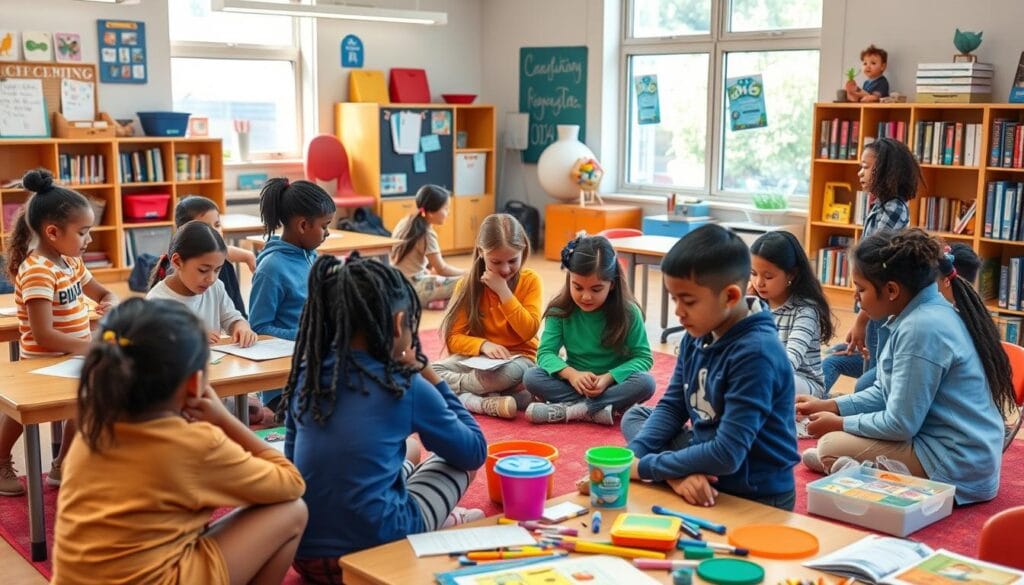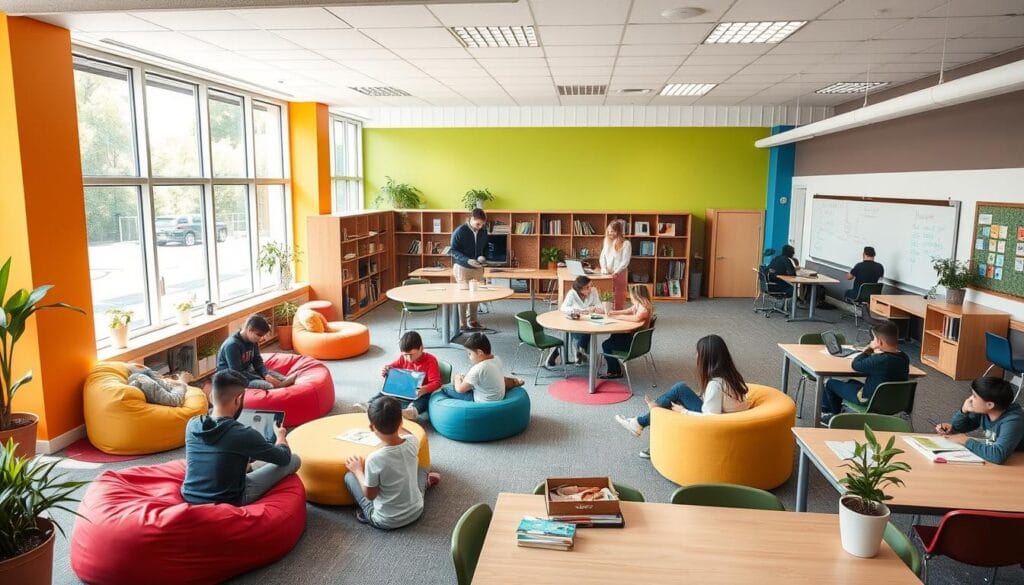Flexible Classroom Strategies: 8 Effective Ways to Boost Success
In today’s changing world, the flexible classroom is a new way to engage students and tailor learning. It lets teachers create a space where students can learn in their own way. This approach encourages teamwork and keeps students involved.
This model puts students at the center of learning. It moves away from teaching everyone the same way. Instead, teachers can adjust their teaching to fit each student’s needs and how they learn best. This makes learning more fun and helps every student do their best.
فهرس المقالة
Understanding the Modern Flexible Classroom Environment
The flexible classroom is changing education. It helps teachers and students learn better. This setup supports differentiated instruction and blended learning. It meets the needs of today’s students.
Key Components of Flexible Learning Spaces
Flexible classrooms are designed to change. They have:
- Movable furniture for different activities
- Technology like laptops and tablets for digital learning
- Spaces for individual, small-group, and whole-class learning
- Good lighting and comfy seats for well-being
Benefits of Adaptable Learning Environments
Flexible classrooms offer many benefits. They:
- Support different learning styles with flexible classroom strategies
- Help with differentiated instruction and personalized learning
- Make blended learning easier, mixing digital and face-to-face teaching
- Boost collaboration, creativity, and critical thinking
- Keep students engaged and in charge of their learning
Traditional vs. Flexible Classroom Setup
Flexible classrooms are different from old classrooms. They let students be active in their learning. Students can move, work in groups, or do independent tasks.
“Flexible classrooms provide the opportunity for students to learn in ways that best suit their individual needs and preferences, fostering a more engaging and personalized educational experience.”
Flexible Classroom Strategies That Drive Student Engagement

In today’s education world, student engagement is key for any flexible classroom’s success. By using active learning strategies and personalized learning, teachers can help students reach their full potential. This makes learning both rewarding and empowering for everyone.
Using personalized learning is a great way to boost student engagement. It means tailoring lessons to fit each student’s learning style and needs. This way, every student feels connected and motivated to learn.
Active learning strategies are also vital. They make students part of the learning process. This includes group talks, hands-on projects, and interactive tech. These methods not only keep students engaged but also help them think critically and solve problems.
Flexible learning and diverse strategies help create a lively, welcoming classroom. This environment boosts student engagement, empowers learners, and prepares them for success.
“Engagement is the foundation for all learning. When students are engaged, they are more likely to be motivated, attentive, and invested in their own learning.” – Dr. Angela Duckworth, Psychologist and author
Implementing Differentiated Instruction in Your Teaching Practice
In today’s classrooms, teaching one way doesn’t work anymore. Teachers need to use differentiated instruction to meet each student’s needs. This approach helps students reach their full potential and creates a welcoming classroom.
Assessment Methods for Different Learning Styles
First, understand the different ways students learn. Some learn best with pictures, while others get it through listening. Use various assessment methods like tests, talks, and projects. This helps you see how each student is doing.
Adapting Content for Diverse Learners
Knowing how students learn, you can change your teaching to fit their needs. Offer personalized learning like different assignments or learning stations. This way, students can learn in the best way for them.
Creating Inclusive Learning Experiences
Differentiated instruction aims to make learning inclusive for everyone. Use formative assessment techniques to check on students and adjust your teaching. Create a classroom that values diversity, teamwork, and supports every student to succeed.
By using differentiated instruction, you make learning personal and engaging. Your classroom becomes a place where everyone’s strengths and needs are valued. With the right mix of assessments, adaptable content, and inclusive practices, all your students can do well and achieve great things.

Leveraging Technology for Blended Learning Success
In today’s classrooms, technology is key for blended learning. This method mixes digital tools with face-to-face teaching. It helps teachers create engaging lessons that meet different learning needs and encourage students to participate.
Technology lets teachers offer personalized learning plans. Students can use digital tools to learn at their own speed. This makes them feel more in control of their education.
Technology also makes learning more fun and exciting. Tools like interactive whiteboards and games keep students interested. They help students dive into new ideas in a fun, interactive way.
| Digital Tool | Application in Flexible Classrooms |
|---|---|
| Online Collaboration Platforms | Facilitate real-time group work, peer-to-peer feedback, and knowledge sharing |
| Formative Assessment Tools | Provide instant feedback, adaptive learning, and data-driven instructional decisions |
| Virtual Simulation Software | Offer immersive, hands-on experiences for experiential learning |
By combining technology with flexible classroom strategies, teachers can make learning exciting. This approach empowers students to be more involved in their education. It leads to better blended learning results.
“The effective use of technology in education not only supports student-centered teaching but also fosters the development of essential 21st-century skills, such as critical thinking, collaboration, and digital literacy.”
Student-Centered Teaching Approaches for Better Learning Outcomes

In today’s classrooms, teaching methods have changed. Gone are the days of just lecturing. Now, teachers focus on making learning personal and engaging. This approach not only boosts grades but also teaches important skills like thinking critically and working together.
Empowering Student Choice and Voice
When students help decide what they learn, they get more excited about it. Let them pick topics, choose how to do assignments, or even help plan lessons. This way, you tap into their interests and strengths, making them feel more involved.
Building Student Autonomy
Teaching students to be independent is key to personalized learning. Encourage them to set goals, track their progress, and think about their learning. Offer help but also let them learn to think for themselves.
Facilitating Peer Learning Opportunities
- Use group projects and discussions to let students learn from each other.
- Try active learning strategies like think-pair-share or jigsaw learning to boost peer interaction.
- Have students give feedback and support to their peers, improving their communication and thinking skills.
By using these methods, you can make learning fun and empowering. Students will be more involved in their education and achieve more.
Designing Effective Project-Based Learning Activities
In the flexible classroom, project-based learning (PBL) is a key strategy. It engages students and helps them grow academically. PBL connects school lessons to real-world problems, making learning active and meaningful.
To create great PBL activities, start by setting clear learning goals. Use open-ended questions that make students think deeply about the subject. Offer chances for hands-on, team work, where students can use their knowledge to solve real problems.
- Let students have a say: Give them a role in deciding the project’s path and outcomes. This makes them feel more invested in their learning.
- Link different subjects together: Mix content from various subjects. This helps students see the bigger picture and how it applies in the real world.
- Be flexible with time and how you assess: Use the flexible classroom’s nature to your advantage. Offer flexible deadlines and different ways to show what students have learned.
By making PBL activities that fit the flexible classroom’s values, you can make learning fun and meaningful. This boosts student engagement and helps them understand the subject better.
“Project-based learning allows students to become active participants in their own education, rather than passive recipients of information.”
Incorporating Active Learning Methods in Daily Instruction
In today’s classrooms, active learning is crucial. It boosts student engagement and understanding. By using movement, group work, and hands-on activities, teachers can make learning fun and diverse.
Movement-Based Learning Activities
Moving around while learning helps students stay focused and remember more. Activities like gallery walks and scavenger hunts let students explore and work together. These methods make the classroom lively and meet the needs of all learners.
Interactive Group Dynamics
Working together is key to learning. Techniques like think-pair-share and jigsaw discussions get students involved and sharing ideas. This way, everyone learns more and has fun doing it.
Hands-On Learning Experiences
Hands-on activities make learning real and exciting. Science experiments and digital simulations let students apply what they’ve learned. These experiences improve engagement and help students think critically.
Using different active learning methods every day makes classrooms better for students. These approaches keep students interested and meet their unique learning needs. This leads to better learning outcomes for everyone.
| Active Learning Method | Description | Benefits |
|---|---|---|
| Movement-Based Activities | Learning activities that incorporate physical movement, such as gallery walks, scavenger hunts, and kinesthetic games. | Increases student attention, enhances knowledge retention, and caters to kinesthetic learners. |
| Interactive Group Dynamics | Collaborative learning activities that encourage students to engage with the material, share perspectives, and learn from one another, such as think-pair-share, jigsaw discussions, and structured debates. | Promotes active engagement, fosters peer learning, and deepens understanding of the subject matter. |
| Hands-On Learning Experiences | Immersive activities that allow students to actively apply their knowledge and develop practical skills, such as science experiments, digital simulations, and project-based learning. | Brings abstract concepts to life, enhances student engagement, and supports the development of critical thinking and problem-solving abilities. |
Maximizing Learning Through Formative Assessment Techniques
In a flexible classroom, formative assessment techniques are key to student success. They offer insights in real-time, helping tailor learning to each student. This approach supports differentiated instruction.
Exit tickets are a great way to check understanding at lesson’s end. They are quick and focused. Teachers use them to spot where students need more help and adjust learning plans.
- Use student reflections to see how well students understand and are engaged.
- Try peer-to-peer assessments to encourage teamwork and get feedback from peers.
- Use digital tools for quick assessments, like online quizzes or polls.
Teachers who use formative assessment techniques well get important data. This helps them adjust teaching to fit each student’s needs. It leads to better learning in the flexible classroom.
“Formative assessment is not something we do to students, but something we do with them to guide ongoing improvement of the teaching and learning process.”- Dylan Wiliam
Creating a Supportive and Dynamic Learning Environment
To make a classroom work well, you need to think about how it’s set up, how students feel, and how things move smoothly. By using smart flexible classroom strategies, teachers can make a place where student-centered teaching and active learning strategies shine.
Physical Space Organization Tips
Set up the classroom so it encourages teamwork and change. Use desks, chairs, and tables that can be moved around for different activities. Add things like bean bags or standing desks to meet different students’ needs.
Building Classroom Community
Make the classroom a welcoming place. Do team-building and group projects to help students get along and respect each other. Make sure students can share their thoughts and feelings easily.
Managing Flexible Transitions
- Make sure everyone knows what to do when the classroom changes.
- Use signs or floor markers to help students move things around.
- Do activities that get students moving to keep them focused during changes.
Focus on the classroom’s setup, how students feel, and smooth transitions. This way, teachers can make a supportive and dynamic learning environment where students can really do their best.

Conclusion
Exploring flexible classroom strategies is key to boosting student engagement and personalized learning. These approaches make the classroom more dynamic. This allows students to reach their full potential.
Using technology for blended learning and active methods in teaching are great ways to start. These strategies help students grow and work together better. They also make sure each student gets the help they need, making learning fair for all.
Flexible classroom practices open up new ways for students to learn and succeed. As an educator, trying out these strategies can make your classroom more exciting. It prepares students for the challenges of today’s world.
FAQ
What are flexible classroom strategies?
Flexible classroom strategies are teaching methods that make learning spaces adaptable. They focus on student-centered learning and use active techniques. This approach caters to different learning styles.
How do flexible classroom strategies enhance student engagement?
These strategies boost student engagement by offering hands-on and personalized learning. They allow students to choose and participate actively. This makes learning more dynamic and interactive.
What are the key components of a flexible learning space?
A flexible learning space has modular furniture and adaptable seating. It also has technology access and areas for group work and individual study. These features support diverse learning needs.
How can differentiated instruction be implemented in a flexible classroom?
Differentiated instruction in a flexible classroom uses various assessments and adapts content. It creates inclusive learning experiences. This personalizes learning for each student.
What is the role of technology in a blended learning approach?
Technology is key in blended learning in a flexible classroom. It supports online and offline learning and personalizes instruction. Effective tech integration enhances the learning experience.
How can project-based learning activities be designed for a flexible classroom?
Designing project-based learning for a flexible classroom involves creating open-ended projects. These projects allow students to explore and apply their knowledge. They develop critical thinking skills in a real-world setting.
What are some active learning strategies that can be incorporated into daily instruction?
Active learning strategies include movement and interactive group work. They encourage engagement and collaboration. These strategies support skill development.
How can formative assessment techniques support personalized learning in a flexible classroom?
Formative assessment techniques like ongoing feedback and self-reflection help adapt instruction. They provide insights into student learning. This allows for personalized learning experiences.
What are some tips for creating a supportive and dynamic learning environment in a flexible classroom?
To create a supportive learning environment, organize the space well and build a strong classroom community. Manage transitions smoothly. These elements make learning positive and engaging.






